engine Alfa Romeo 166 2007 Owner handbook (in English)
[x] Cancel search | Manufacturer: ALFA ROMEO, Model Year: 2007, Model line: 166, Model: Alfa Romeo 166 2007Pages: 272, PDF Size: 4.17 MB
Page 114 of 272
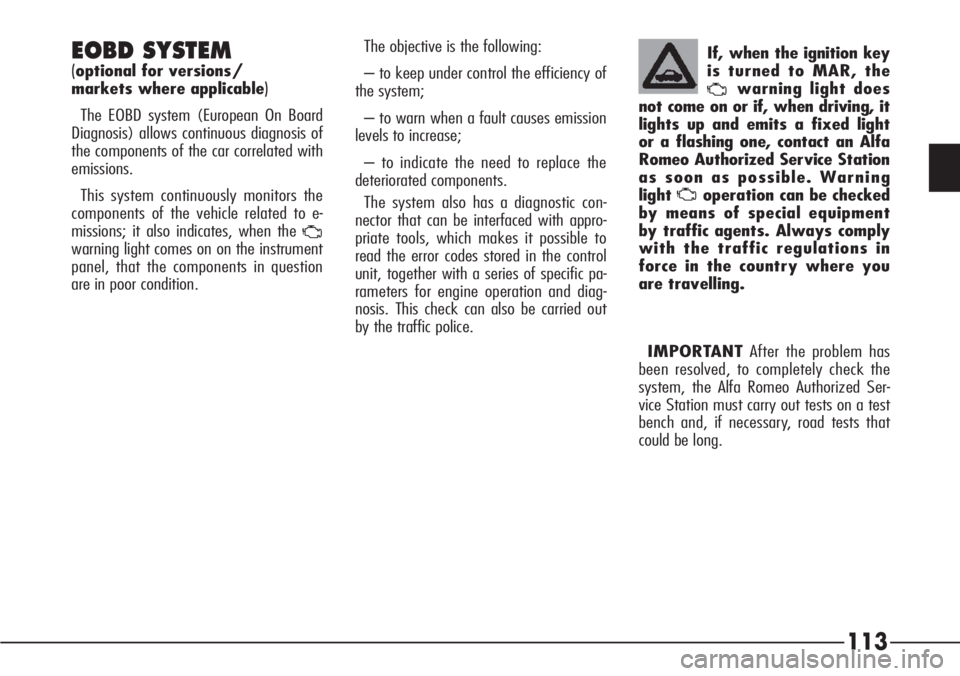
113
EOBD SYSTEM
(optional for versions/
markets where applicable
)
The EOBD system (European On Board
Diagnosis) allows continuous diagnosis of
the components of the car correlated with
emissions.
This system continuously monitors the
components of the vehicle related to e-
missions; it also indicates, when the
Uwarning light comes on on the instrument
panel, that the components in question
are in poor condition.
IMPORTANTAfter the problem has
been resolved, to completely check the
system, the Alfa Romeo Authorized Ser-
vice Station must carry out tests on a test
bench and, if necessary, road tests that
could be long.If, when the ignition key
is turned to MAR, the
Uwarning light does
not come on or if, when driving, it
lights up and emits a fixed light
or a flashing one, contact an Alfa
Romeo Authorized Service Station
as soon as possible. Warning
light
Uoperation can be checked
by means of special equipment
by traffic agents. Always comply
with the traffic regulations in
force in the country where you
are travelling.
The objective is the following:
– to keep under control the efficiency of
the system;
– to warn when a fault causes emission
levels to increase;
– to indicate the need to replace the
deteriorated components.
The system also has a diagnostic con-
nector that can be interfaced with appro-
priate tools, which makes it possible to
read the error codes stored in the control
unit, together with a series of specific pa-
rameters for engine operation and diag-
nosis. This check can also be carried out
by the traffic police.
Page 116 of 272
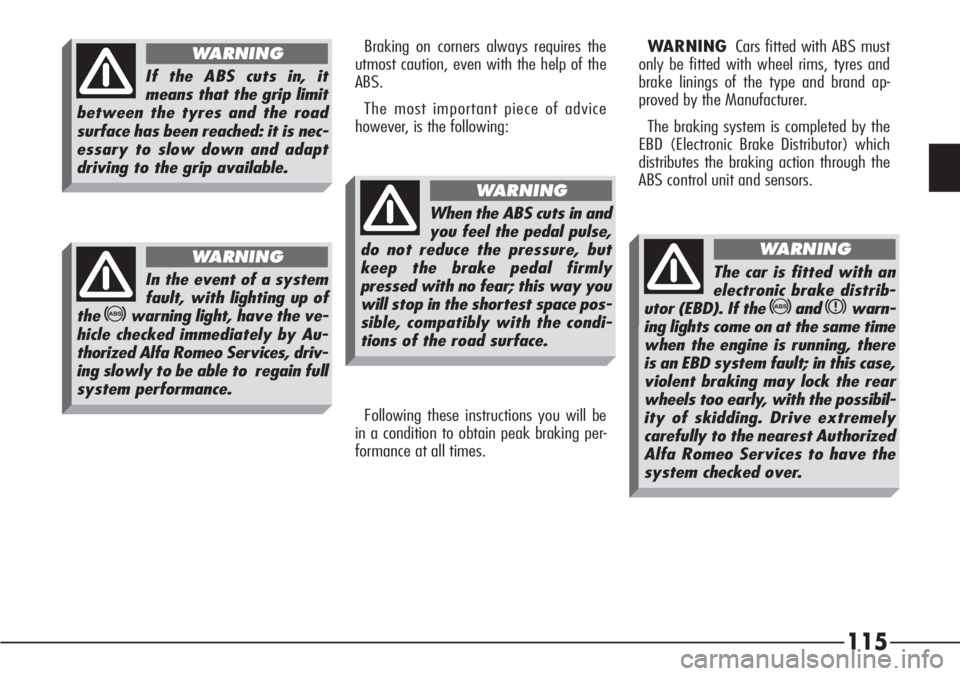
115
Braking on corners always requires the
utmost caution, even with the help of the
ABS.
The most important piece of advice
however, is the following:WARNINGCars fitted with ABS must
only be fitted with wheel rims, tyres and
brake linings of the type and brand ap-
proved by the Manufacturer.
The braking system is completed by the
EBD (Electronic Brake Distributor) which
distributes the braking action through the
ABS control unit and sensors.
Following these instructions you will be
in a condition to obtain peak braking per-
formance at all times.
If the ABS cuts in, it
means that the grip limit
between the tyres and the road
surface has been reached: it is nec-
essary to slow down and adapt
driving to the grip available.
WARNING
In the event of a system
fault, with lighting up of
the
>warning light, have the ve-
hicle checked immediately by Au-
thorized Alfa Romeo Services, driv-
ing slowly to be able to regain full
system performance.
WARNING
When the ABS cuts in and
you feel the pedal pulse,
do not reduce the pressure, but
keep the brake pedal firmly
pressed with no fear; this way you
will stop in the shortest space pos-
sible, compatibly with the condi-
tions of the road surface.
WARNING
The car is fitted with an
electronic brake distrib-
utor (EBD). If the
>andxwarn-
ing lights come on at the same time
when the engine is running, there
is an EBD system fault; in this case,
violent braking may lock the rear
wheels too early, with the possibil-
ity of skidding. Drive extremely
carefully to the nearest Authorized
Alfa Romeo Services to have the
system checked over.
WARNING
Page 117 of 272
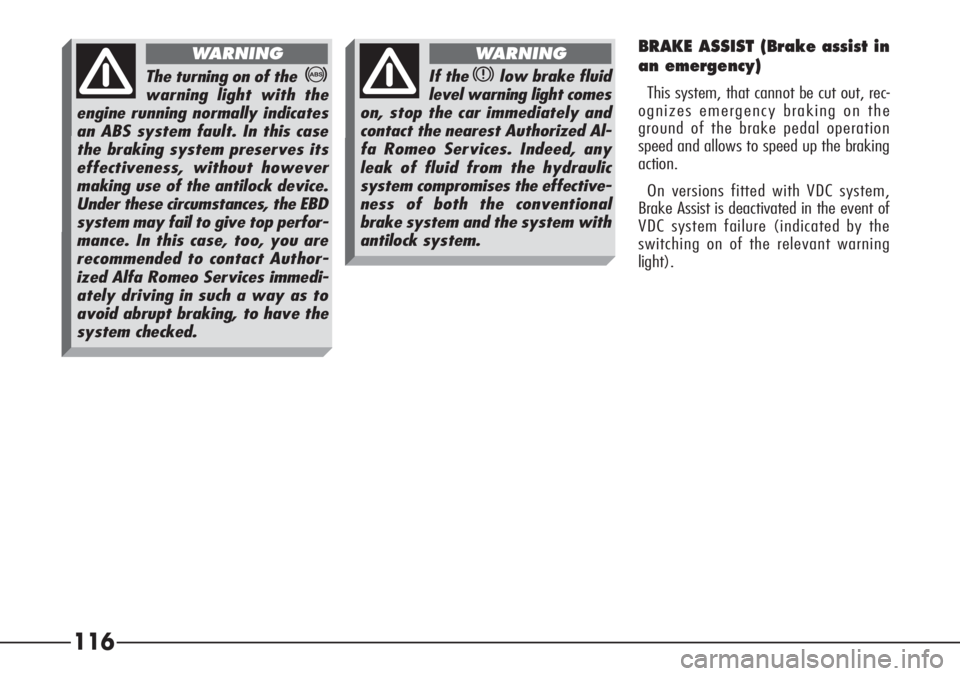
116
BRAKE ASSIST (Brake assist in
an emergency)
This system, that cannot be cut out, rec-
ognizes emergency braking on the
ground of the brake pedal operation
speed and allows to speed up the braking
action.
On versions fitted with VDC system,
Brake Assist is deactivated in the event of
VDC system failure (indicated by the
switching on of the relevant warning
light).
The turning on of the>
warning light with the
engine running normally indicates
an ABS system fault. In this case
the braking system preserves its
effectiveness, without however
making use of the antilock device.
Under these circumstances, the EBD
system may fail to give top perfor-
mance. In this case, too, you are
recommended to contact Author-
ized Alfa Romeo Services immedi-
ately driving in such a way as to
avoid abrupt braking, to have the
system checked.
WARNING
If the xlow brake fluid
level warning light comes
on, stop the car immediately and
contact the nearest Authorized Al-
fa Romeo Services. Indeed, any
leak of fluid from the hydraulic
system compromises the effective-
ness of both the conventional
brake system and the system with
antilock system.
WARNING
Page 118 of 272
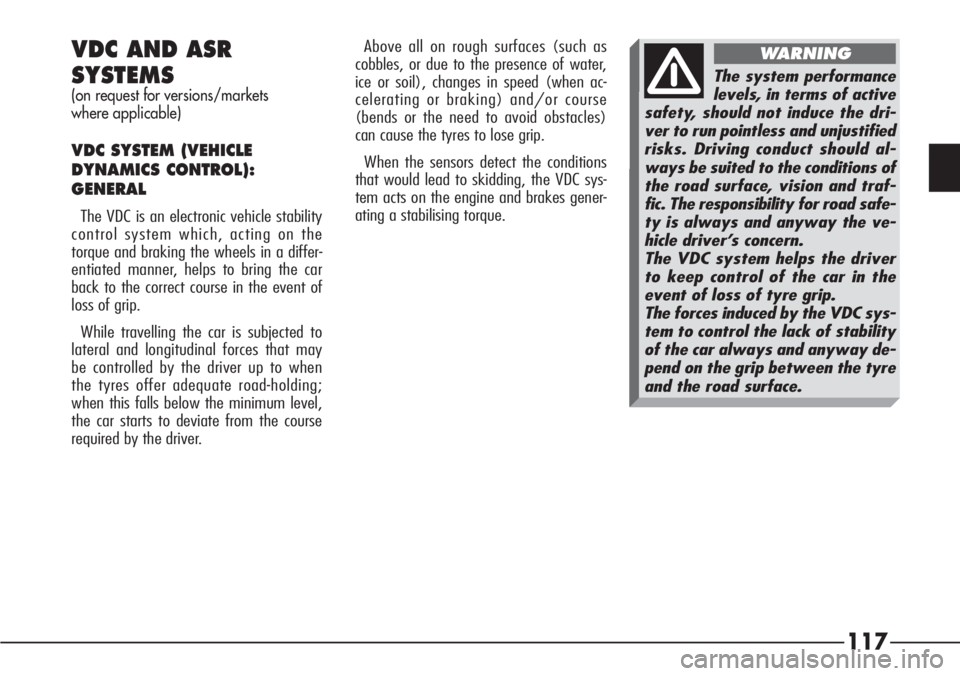
117
VDC AND ASR
SYSTEMS
(on request for versions/markets
where applicable)
VDC SYSTEM (VEHICLE
DYNAMICS CONTROL):
GENERAL
The VDC is an electronic vehicle stability
control system which, acting on the
torque and braking the wheels in a differ-
entiated manner, helps to bring the car
back to the correct course in the event of
loss of grip.
While travelling the car is subjected to
lateral and longitudinal forces that may
be controlled by the driver up to when
the tyres offer adequate road-holding;
when this falls below the minimum level,
the car starts to deviate from the course
required by the driver.Above all on rough surfaces (such as
cobbles, or due to the presence of water,
ice or soil), changes in speed (when ac-
celerating or braking) and/or course
(bends or the need to avoid obstacles)
can cause the tyres to lose grip.
When the sensors detect the conditions
that would lead to skidding, the VDC sys-
tem acts on the engine and brakes gener-
ating a stabilising torque.
The system performance
levels, in terms of active
safety, should not induce the dri-
ver to run pointless and unjustified
risks. Driving conduct should al-
ways be suited to the conditions of
the road surface, vision and traf-
fic. The responsibility for road safe-
ty is always and anyway the ve-
hicle driver’s concern.
The VDC system helps the driver
to keep control of the car in the
event of loss of tyre grip.
The forces induced by the VDC sys-
tem to control the lack of stability
of the car always and anyway de-
pend on the grip between the tyre
and the road surface.
WARNING
Page 119 of 272
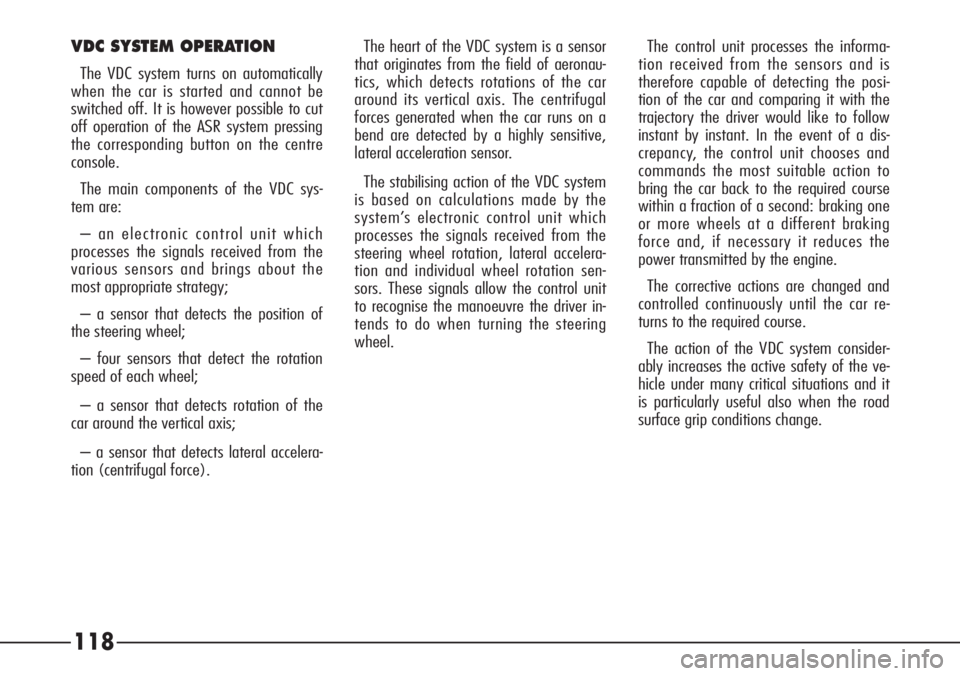
The heart of the VDC system is a sensor
that originates from the field of aeronau-
tics, which detects rotations of the car
around its vertical axis. The centrifugal
forces generated when the car runs on a
bend are detected by a highly sensitive,
lateral acceleration sensor.
The stabilising action of the VDC system
is based on calculations made by the
system’s electronic control unit which
processes the signals received from the
steering wheel rotation, lateral accelera-
tion and individual wheel rotation sen-
sors. These signals allow the control unit
to recognise the manoeuvre the driver in-
tends to do when turning the steering
wheel.
118
VDC SYSTEM OPERATION
The VDC system turns on automatically
when the car is started and cannot be
switched off. It is however possible to cut
off operation of the ASR system pressing
the corresponding button on the centre
console.
The main components of the VDC sys-
tem are:
– an electronic control unit which
processes the signals received from the
various sensors and brings about the
most appropriate strategy;
– a sensor that detects the position of
the steering wheel;
– four sensors that detect the rotation
speed of each wheel;
– a sensor that detects rotation of the
car around the vertical axis;
– a sensor that detects lateral accelera-
tion (centrifugal force).The control unit processes the informa-
tion received from the sensors and is
therefore capable of detecting the posi-
tion of the car and comparing it with the
trajectory the driver would like to follow
instant by instant. In the event of a dis-
crepancy, the control unit chooses and
commands the most suitable action to
bring the car back to the required course
within a fraction of a second: braking one
or more wheels at a different braking
force and, if necessary it reduces the
power transmitted by the engine.
The corrective actions are changed and
controlled continuously until the car re-
turns to the required course.
The action of the VDC system consider-
ably increases the active safety of the ve-
hicle under many critical situations and it
is particularly useful also when the road
surface grip conditions change.
Page 120 of 272

119
The action of the ASR system is particu-
larly helpful under the following condi-
tions:
– Skidding of the inner wheel on a
bend, due to the effect of the dynamic
changes of the load or over-accelerating.
– Excessive power transmitted to the
wheels, also in relation to the conditions
of the road surface.
– Acceleration on slippery, snowy or icy
surfaces.
– In the case of loss of grip on a wet
surface (aquaplaning).ASR FUNCTION (ANTISLIP
REGULATION): GENERAL
The ASR system integrates the VDC sys-
tem controlling the vehicle drive and com-
ing into operation automatically each
time one or both driving wheels skid.
Two different control systems are acti-
vated, depending on the skidding condi-
tions:
– If skidding concerns both driving
wheels, because it is caused by the exces-
sive power transmitted, the ASR system
cuts in reducing the power transmitted by
the engine.
– If skidding concerns only one driving
wheel, the ASR system cuts in automati-
cally braking the skidding wheel, with an
effect similar to that of a self-locking dif-
ferential.
For the VDC, ASR and
ABS systems to work
correctly, the tyres must be of the
same brand and type on all
wheels, in perfect conditions and
above all of the specified type,
brand and size.
WARNING
Page 121 of 272
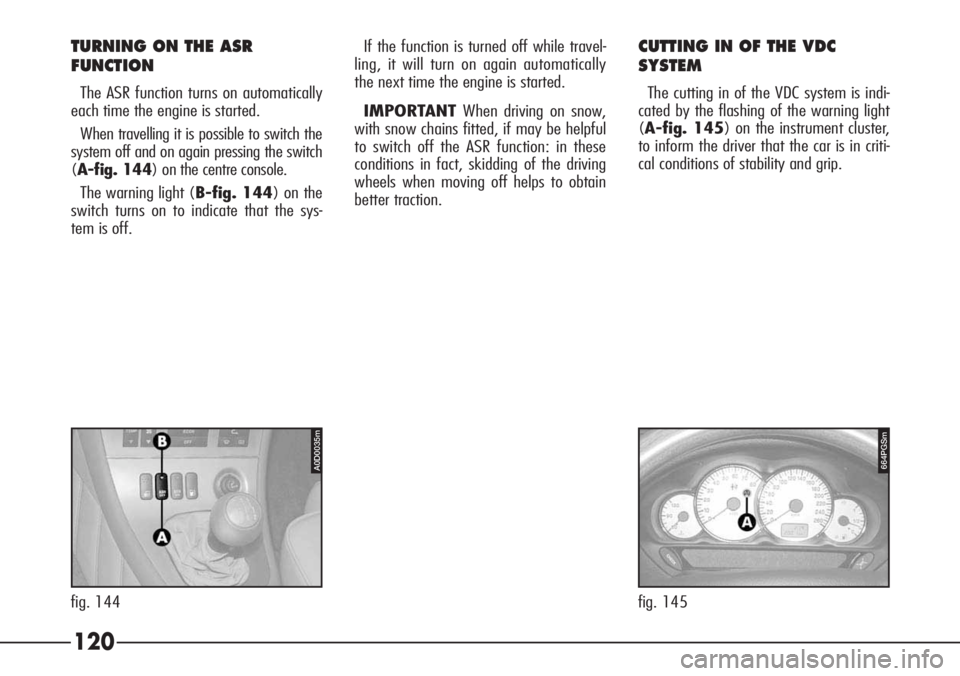
120
TURNING ON THE ASR
FUNCTION
The ASR function turns on automatically
each time the engine is started.
When travelling it is possible to switch the
system off and on again pressing the switch
(A-fig. 144) on the centre console.
The warning light (B-fig. 144) on the
switch turns on to indicate that the sys-
tem is off.If the function is turned off while travel-
ling, it will turn on again automatically
the next time the engine is started.
IMPORTANTWhen driving on snow,
with snow chains fitted, if may be helpful
to switch off the ASR function: in these
conditions in fact, skidding of the driving
wheels when moving off helps to obtain
better traction.
CUTTING IN OF THE VDC
SYSTEM
The cutting in of the VDC system is indi-
cated by the flashing of the warning light
(A-fig. 145) on the instrument cluster,
to inform the driver that the car is in criti-
cal conditions of stability and grip.
664PGSm
fig. 145
A0D0035m
fig. 144
Page 122 of 272
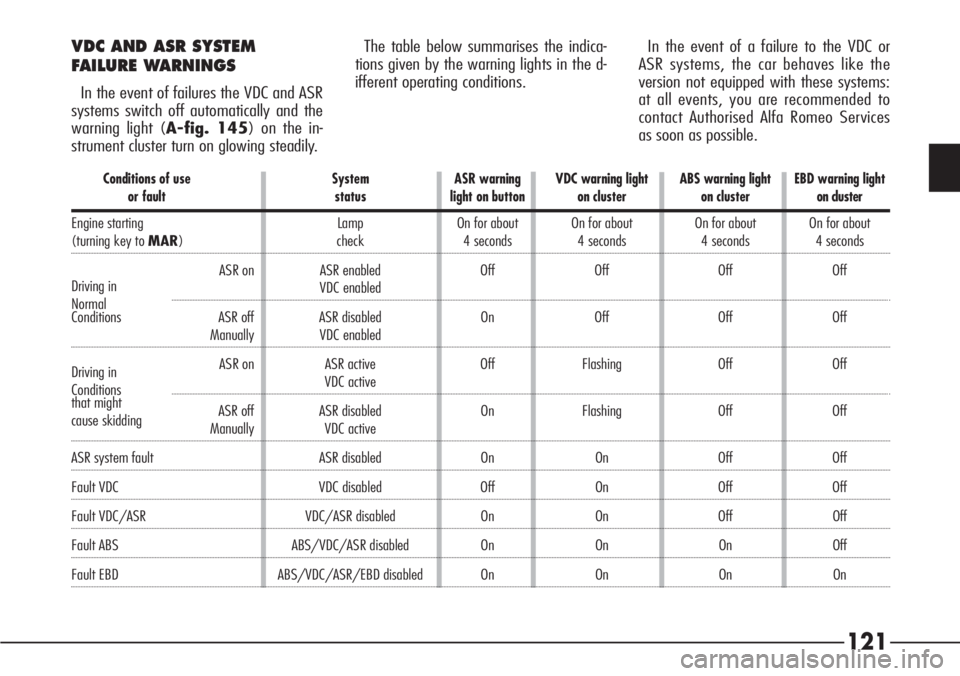
121
VDC AND ASR SYSTEM
FAILURE WARNINGS
In the event of failures the VDC and ASR
systems switch off automatically and the
warning light (A-fig. 145) on the in-
strument cluster turn on glowing steadily.The table below summarises the indica-
tions given by the warning lights in the d-
ifferent operating conditions.In the event of a failure to the VDC or
ASR systems, the car behaves like the
version not equipped with these systems:
at all events, you are recommended to
contact Authorised Alfa Romeo Services
as soon as possible.
Conditions of use System ASR warning VDC warning light ABS warning light EBD warning light
or fault status light on button on cluster on cluster on cluster
Engine starting Lamp On for about On for about On for about On for about
(turning key to MAR) check 4 seconds 4 seconds 4 seconds 4 seconds
Driving inASR on ASR enabled Off Off Off Off
NormalVDC enabled
Conditions ASR off ASR disabled On Off Off Off
Manually VDC enabled
Driving inASR on ASR active Off Flashing Off Off
ConditionsVDC active
that might
ASR off ASR disabled On Flashing Off Off
cause skidding
Manually VDC active
ASR system fault ASR disabled On On Off Off
Fault VDC VDC disabled Off On Off Off
Fault VDC/ASR VDC/ASR disabled On On Off Off
Fault ABS ABS/VDC/ASR disabled On On On Off
Fault EBD ABS/VDC/ASR/EBD disabled On On On On
Page 125 of 272
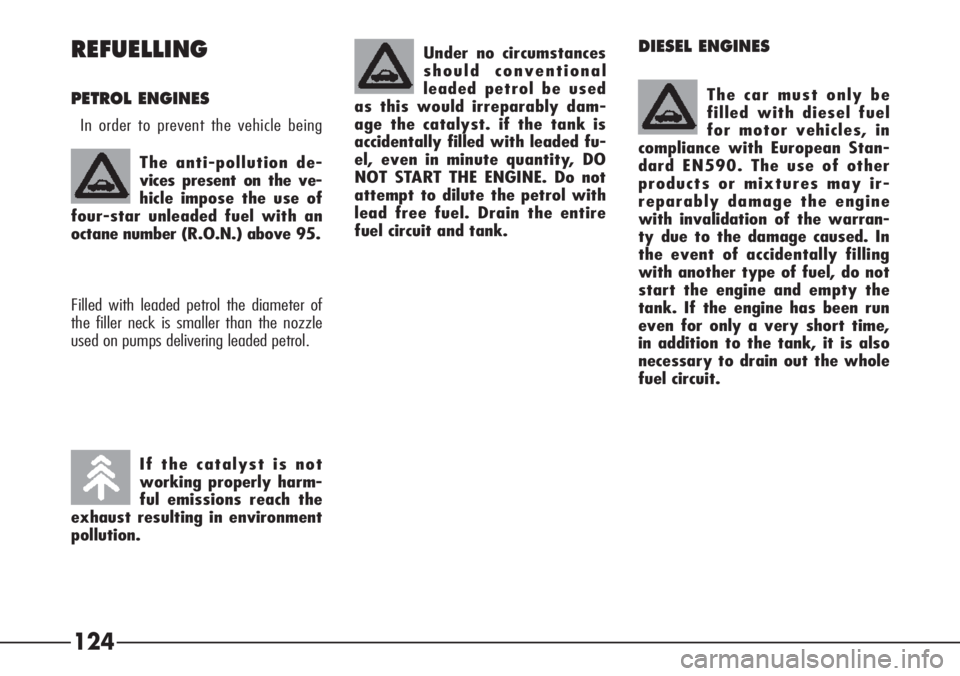
Under no circumstances
should conventional
leaded petrol be used
as this would irreparably dam-
age the catalyst. if the tank is
accidentally filled with leaded fu-
el, even in minute quantity, DO
NOT START THE ENGINE. Do not
attempt to dilute the petrol with
lead free fuel. Drain the entire
fuel circuit and tank.The car must only be
filled with diesel fuel
for motor vehicles, in
compliance with European Stan-
dard EN590. The use of other
products or mixtures may ir-
reparably damage the engine
with invalidation of the warran-
ty due to the damage caused. In
the event of accidentally filling
with another type of fuel, do not
start the engine and empty the
tank. If the engine has been run
even for only a very short time,
in addition to the tank, it is also
necessary to drain out the whole
fuel circuit.DIESEL ENGINES
124
The anti-pollution de-
vices present on the ve-
hicle impose the use of
four-star unleaded fuel with an
octane number (R.O.N.) above 95.
If the catalyst is not
working properly harm-
ful emissions reach the
exhaust resulting in environment
pollution.
REFUELLING
PETROL ENGINES
In order to prevent the vehicle being
Filled with leaded petrol the diameter of
the filler neck is smaller than the nozzle
used on pumps delivering leaded petrol.
Page 126 of 272
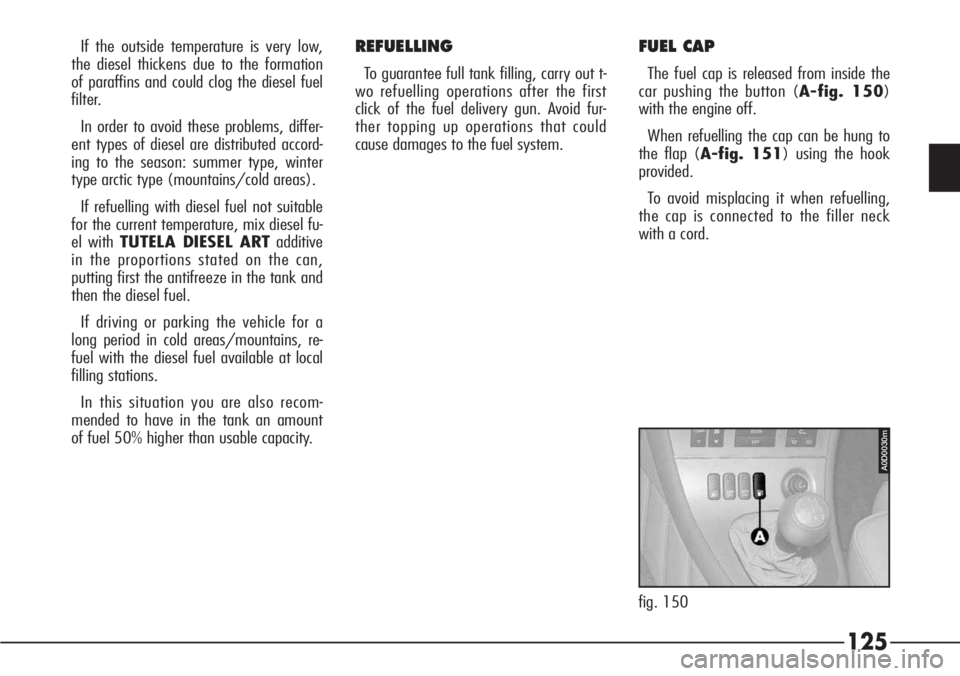
125
If the outside temperature is very low,
the diesel thickens due to the formation
of paraffins and could clog the diesel fuel
filter.
In order to avoid these problems, differ-
ent types of diesel are distributed accord-
ing to the season: summer type, winter
type arctic type (mountains/cold areas).
If refuelling with diesel fuel not suitable
for the current temperature, mix diesel fu-
el with TUTELA DIESEL ARTadditive
in the proportions stated on the can,
putting first the antifreeze in the tank and
then the diesel fuel.
If driving or parking the vehicle for a
long period in cold areas/mountains, re-
fuel with the diesel fuel available at local
filling stations.
In this situation you are also recom-
mended to have in the tank an amount
of fuel 50% higher than usable capacity.FUEL CAP
The fuel cap is released from inside the
car pushing the button (A-fig. 150)
with the engine off.
When refuelling the cap can be hung to
the flap (A-fig. 151) using the hook
provided.
To avoid misplacing it when refuelling,
the cap is connected to the filler neck
with a cord.
A0D0030m
fig. 150
REFUELLING
To guarantee full tank filling, carry out t-
wo refuelling operations after the first
click of the fuel delivery gun. Avoid fur-
ther topping up operations that could
cause damages to the fuel system.